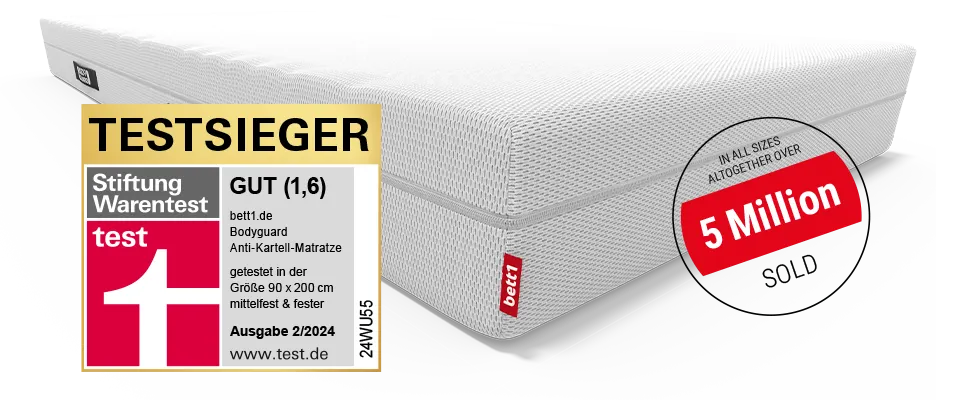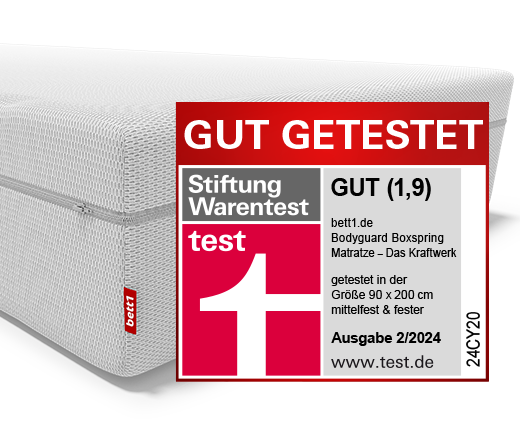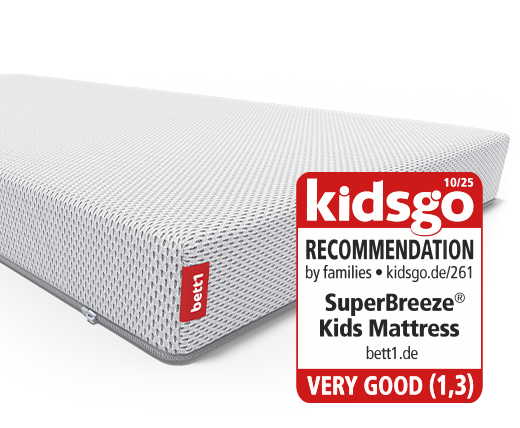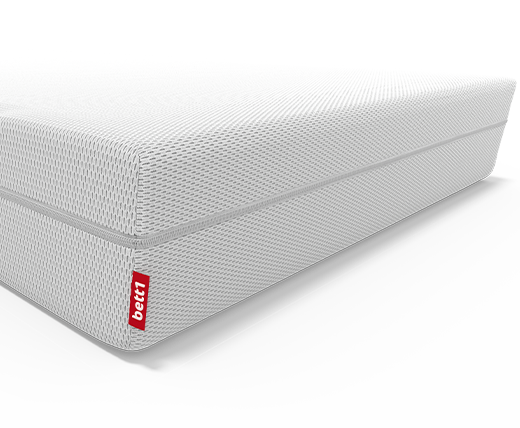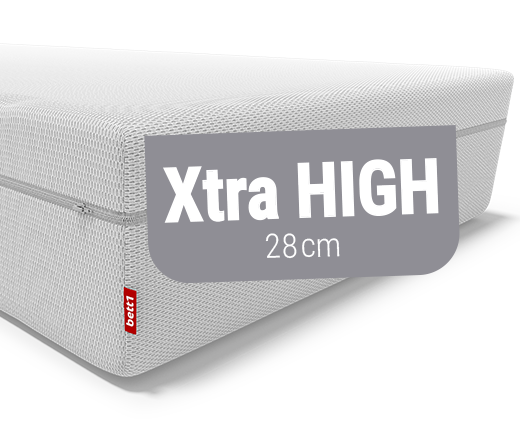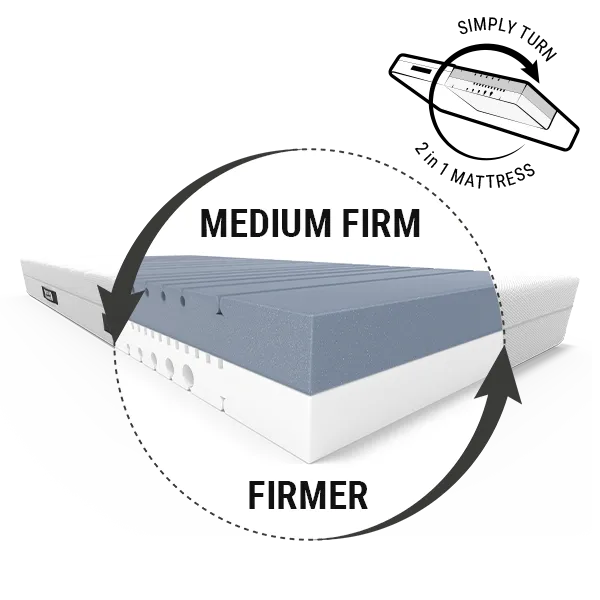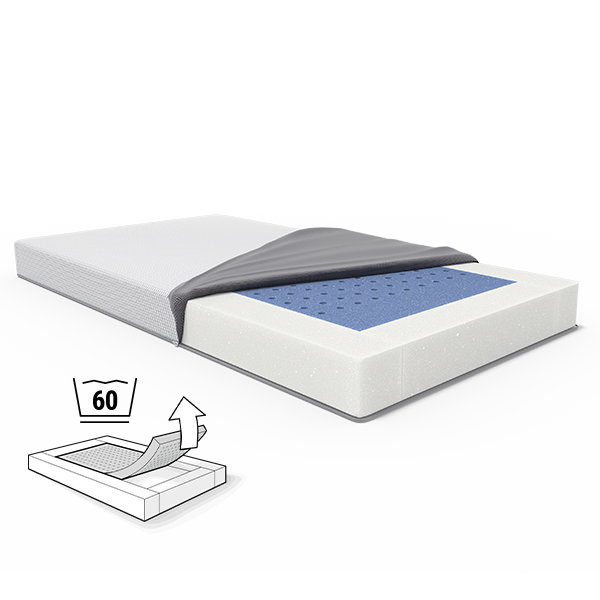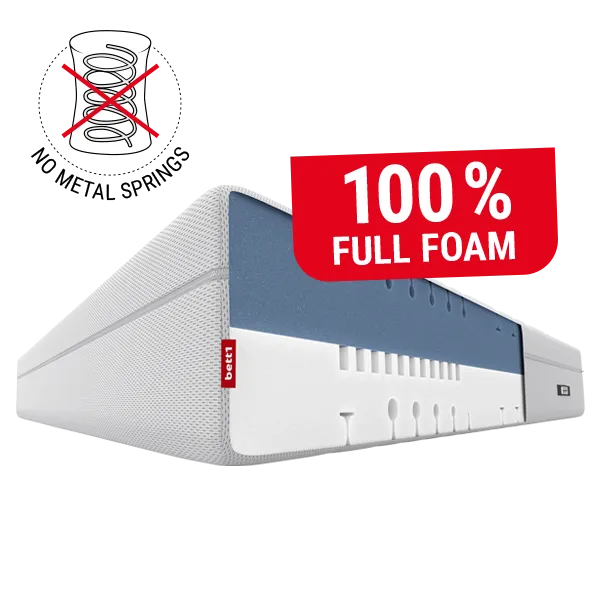
Mattresses
Our product advisor
Which Mattress Suits You?
Answer the following eight questions and find out which mattress is right for you.
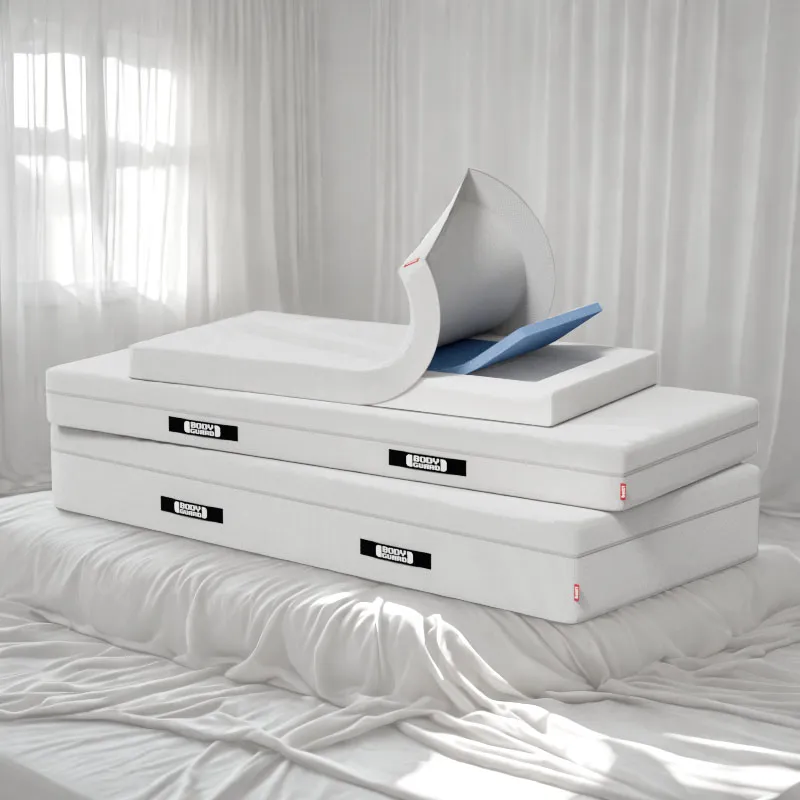
Question 1
Who should sleep on the mattress?
Question 2
Which bed do you have?
Question 3
How do you feel about heat?
Question 4
How much do you weigh?
Question 5
Where is your center of gravity?
Question 6
Do you prefer a softer or firmer sleep?
Question 7
What is your favourite sleeping position?
Question 8
How much are you willing to spend?
Your dream mattress
This is the mattress you won't get far on when counting sheep.
Unfortunately we have not found a product that meets the specified requirements. Please try again or have a look around our shop first.
Good mattresses are the basis for restful sleep. The concept of the mattress has existed for thousands of years. However, the first constructions made of plant fibres or animal skins were probably much less comfortable than today's mattresses. Over time, three main types of mattress became established: Latex mattresses, innerspring mattresses and cold foam mattresses. Mattresses filled with water also became popular from the 1960s onwards. However, like futon mattresses, water mattresses remained a temporary phenomenon: niche mattresses. What makes the common mattress materials so popular and what actually makes a good mattress?

Latex
Mattresses
Latex mattresses are made from synthetic or natural rubber. They are comparatively heavy and are considered soft and stable. Due to their density, hardly any moisture can penetrate the mattress core, which is why latex mattresses are considered to be particularly hygienic. However, you have to clean these mattresses regularly, otherwise their lifespan will suffer.

Spring
Mattress
There are three types of spring mattress. Bonell spring core: Connected springs give way over a large area when pressure is applied.This favours squeaking and the "hammock effect". Pocket spring core and barrel pocket spring core: Individually sewn springs give way selectively. As spring cores have many air spaces inside, they are less effective at keeping you warm.

Foam
Mattresses
The generic term cold foam mattresses refers to different foam mattresses. The best-known foam mattresses are made of polyurethane (PU or PUR foam), moulded foam, visco foam or gel foam. Foam mattresses tend to be warming and point-elastic.

Mattress from QXSchaum®
QXSchaum® matress foam is used in our BODYGUARD® Mattresses. This cold foam specially developed for mattresses is a further development of conventional polyurethane foam. Compared to conventional polyurethane foam mattresses, mattresses made from QXSchaum® are durable and retain their shape even after years of use. QXSchaum® is also characterised by its high point elasticity - it therefore yields exactly where the pressure occurs. This is particularly advantageous if you are not sleeping alone on the mattress, as one person does not cause the other person's side of the bed to shake when turning over.
Surface Elasticity vs. Point Elasticity
Point-elastic mattresses yield at specific points, i.e. exactly at the point where the mattress is under pressure. If you exert pressure on an area-elastic mattress, not only does this point give way, but also the area around the load point. A good mattress not only yields precisely to the point, but also to the depth of the pressure. On the other hand, the body is supported and the natural double S-curvature of the spine is maintained. In this way, it ensures that differently shaped bodies lie comfortably on it. The QXSchaum® and the sophisticated incisions of the BODYGUARD® Mattresses ensure ergonomic mattress properties for years to come.
Which Mattress for Whom?
Different materials have different advantages. With QXSchaum®, we rely on an all-rounder among mattress types. QXSchaum® mattresses combine the positive properties of different mattresses, such as the durability of latex mattresses or the breathability of spring mattresses. In addition, QXSchaum® has its own qualities, such as a light weight, which makes these mattresses particularly easy to handle. An excellent all-rounder and therefore flexible to use - even on adjustable slatted frames. To find out which mattress is right for you, we recommend an extensive sleep trial.

Finding the Right Firmness Level
Some people prefer firmer mattresses and others softer. You shouldn't take commercial information that recommends a firmness level depending on your body weight too seriously. The firmness level of mattresses is given as H1 to H5, with H1 being very soft and H5 very firm. The most popular firmness level in Germany is H3 (medium firm), followed by H2 (soft) and H4 (firm). The firmness grades H1 (very soft) and H5 (very firm) are offered rather rarely. While you have to decide on a firmness level for most mattresses, with the BODYGUARD® Mattresses we offer you two firmness levels and 100 nights to try them out. To lie firmer or softer, you can simply turn the BODYGUARD® Mattress over.
Mattress Sizes
The most popular mattress size in Germany is the 90×200 cm mattress. This is not only due to singles, this mattress size is often bought twice. The mattresses then fit into a 180 cm wide double bed and each side can be fitted with an individual firmness level.
Our BODYGUARD® Mattresses are available in numerous sizes:
| Mattress Width 190 cm
|
Mattress Width 200 cm
|
Mattress Width 210 cm
|
Mattress Width 220 cm
|
| Mattress 70x200 cm | |||
| Mattress 80x190 cm | Mattress 80x200 cm | Mattress 80x210 cm | Mattress 80x220 cm |
| Mattress 90x190 cm | Mattress 90x200 cm | Mattress 90x210 cm | Mattress 90x220 cm |
| Mattress 100x190 cm | Mattress 100x200 cm | Mattress 100x210 cm | Mattress 100x220 cm |
| Mattress 120x190 cm | Mattress 120x200 cm | Mattress 120x220 cm | |
| Mattress 130x190 cm | Mattress 130x200 cm | ||
| Mattress 135x190 cm | Mattress 135x200 cm | ||
| Mattress 140x190 cm | Mattress 140x200 cm |
Mattress 140x210 cm | Mattress 140x220 cm |
| Mattress 150x190 cm | Mattress 150x200 cm | ||
| Mattress 160x190 cm | Mattress 160x200 cm | Mattress 160x210 cm | Mattress 160x220 cm |
| Mattress 180x190 cm | Mattress 180x200 cm |
Mattress 180x210 cm | Mattress 180x220 cm |
| Mattress 200x200 cm | Mattress 200x210 cm | Mattress 200x220 cm |
For newborns, babies and toddlers, we offer the SuperBreeze® Kids Mattress in sizes 60x120, 70x140 and 80x160 cm.
Single Mattresses
The 90x200 cm mattress is popular in many single households or shared flats. If you sleep alone but would prefer more sleeping space or want to be prepared for visitors, mattress widths between 100 and 120 cm are a good alternative to the classic mattress.
Mattresses for Two
The classic French bed with a 140x200 cm mattress is the smallest of the double mattresses. If you don't mind physical closeness, this space-saving double bed is ideal. The classic double bed in Germany usually measures 160 x 200 cm. You can sleep on it permanently as a couple without any problems. The bed is even more comfortable with a 180 x 200 cm queen-size mattress or a 200 x 200 cm king-size bed.
Special Sizes and Excess Lengths
Mattresses should have about 10 cm clearance at both the head and foot ends. From a height of 1.80 m, it is worth considering a mattress length of 210 cm or 220 cm. Although these sizes are often a little more expensive, they are usually still available in the standard range in mattress shops. The BODYGUARD® Mattress can normally be ordered up to a size of 200 x 220 cm. As older bed frames are only 190 cm long, the BODYGUARD® Mattress is also available in 190 cm length.
Test Sleep or Test Lying?
We are convinced that you can't get a real impression of your mattress by spending a few minutes trying it out in a shop. Why not? Test lying in a shop:
- Street clothes distort the lying sensation
- nAfter a long day, every mattress initially feels comfortable
- The decisive factor is the feeling of waking up

So that you can be sure that you have found the right mattress for you, we offer you an extensive trial sleep period. After all, it takes several nights or even weeks for the body to get used to the new sleeping surface. You can therefore try out the BODYGUARD® Mattress for 100 nights. As a rule, you won't give it back afterwards. And if it doesn't suit you, you simply get your money back.
The BODYGUARD® Mattress
Mattresses have never been as advanced as they are today. For a long time, buying a new mattress was a costly and complicated affair. The various mattress offers, statements and recommendations resembled an impenetrable thicket of information and confusion. Adam Szpyt, founder and managing director of bett1.de, therefore had the idea of developing a qualitative solution.

As little as possible, as much as necessary: the price alone does not indicate the quality. High-quality models are available from as little as 199 euro.
The BODYGUARD® mattress from bett1.de is made from advanced QXSchaum® mattress foam and retains its shape for a particularly long time. bett1.de offers a 10-year warranty on the mattress core.
The decisive factor is not so much the height as the material and its workmanship. Good cold foam mattresses are point-elastic and durable. This is possible from a height of 18 cm.
The best mattress is the one that allows you to wake up feeling relaxed and refreshed in the morning. It is crucial that it adapts to your body shape and provides precise support and relief for different parts of your body.
If you notice that your mattress no longer provides sufficient support or you wake up in the morning with tension or back pain, it is time for a new one. A mattress should also be replaced after about ten years at the latest for hygienic reasons.
You can care for your mattress by vacuuming it regularly and airing it well. It is best to leave it uncovered during the day so that moisture can evaporate. Protect it further with a suitable cover and treat stains immediately without soaking the mattress. With a good mattress, you don't need to turn it over and over to prevent it from becoming worn.

